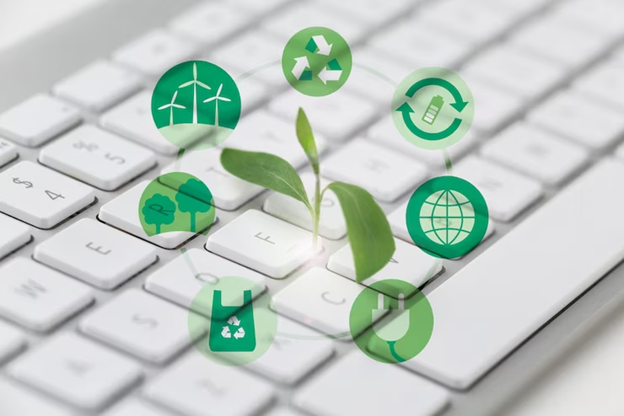Views: 0
 547
547
Image Source:
We’ve crossed many tipping points when it comes to climate change. According to a 2022 report by the Intergovernmental Panel on Climate Change (IPCC), unless organizations take immediate steps to reduce greenhouse gas emissions, the communities where we live and work — and entire ecosystems that provide valuable commodities — may cease to exist.
While there is widespread support for reversing the conditions that have led us to these tipping points, many businesses encounter significant challenges in reducing their carbon footprint and developing more sustainable business practices. In fact, many companies aren’t aware that their digital solutions may be contributing to the problem. However, everyone working in software development should consider the environmental impact of their software development and use.
Several organizations and individuals do not realize that software, like computer hardware, may contribute to environmental concerns. While the software does not directly consume energy, it affects the operation of computer hardware, thereby influencing the hardware’s energy use and carbon emissions. Computationally inefficient software negatively impacts energy consumption and, by extension, environmental sustainability.
Sustainable software, also known as green software or green coding, is a concept shaping the future of software engineering. Its emphasis on minimizing environmental damage through software engineering is attracting increasing interest from developers, designers, and architects who want to make a meaningful and lasting contribution to saving the planet.
In this article, we’ll take a closer look at emerging concepts, principles, and practices that enable green software engineering and development.
Sustainable Software Engineering
Sustainable or green software engineering is a method of designing and deploying software that focuses on energy efficiency and environmental sustainability. Its goal is to minimize the environmental impact of applications, software architecture, and the infrastructure that hosts and runs these applications.
It involves every facet of the software development life cycle — including design, use, and ecological, economic, and social impacts. Green coding has a significant role in reducing carbon emissions and enhancing sustainability initiatives of small, medium, and big enterprises.
Green software prioritizes the following design, development, implementation, and deployment principles:
- It must limit its energy consumption and environmental impact.
- It must include green and sustainable software development practices.
- It must include green and sustainable software architecture and hardware.
- It must reduce greenhouse gas emissions and carbon footprint.
Green Software Development Principles
Sustainable software development has traditionally prioritized cost-effectiveness, speed, and agility over the potential to reduce emissions and increase sustainability. The Green Software Foundation, a non-profit organization founded in 2021 to create a network of people, tools, and best practices for green software, is leading a global consensus on green software principles and standards.
The foundation has established eight fundamental principles to guide software engineers in their approach to software development.
- Carbon: Build carbon-efficient applications.
- Electricity: Build energy-efficient applications.
- Embodied Carbon: Build hardware-efficient applications.
- Demand Shaping: Build carbon-aware applications.
- Carbon Intensity: Consume electricity with the lowest carbon emissions.
- Energy Proportionality: Maximize how efficiently the hardware uses energy.
- Measurement and Optimization: Focus on incremental adjustments that boost overall carbon efficiency.
- Networking: Reduce the amount of data and distance the software must travel through the network.
Green Software Development Practices
In addition to accessibility, functionality, and security, we must consider energy efficiency and sustainability as crucial parameters to create and promote greener software. We must also consider long-term use, reuse, and minimal computational and memory resource requirements when building greener software.
Here are some of the best practices and recommendations for developing environmentally friendly software:
1. Design and Coding
You can introduce green thinking to businesses and modern ways of working with relative ease. To promote a message of sustainability, a development team can integrate green thinking and practices into all aspects of their delivery, whether they use a traditional or low-code/no-code development approach.
Adopting the following principles can help your development team create greener software:
- Concentrate on and regulate features with high power consumption and frequent usage situations.
- Use an efficient caching strategy to reduce data utilization. Reduce data exchange, manage the lifecycle of stored data, compress and aggregate data, and use smaller media and image sizes when possible.
- Remove or restructure outdated features to improve the software’s energy efficiency and maintenance.
- Identify and eliminate loops that do not serve their intended purpose and waste energy.
- Modify the application’s behavior based on the device’s power mode or other operating conditions.
- Monitor the application’s real-time energy consumption to find modules that you can optimize to produce fewer emissions.
2. Choice of Language
Even the coding language you use — C++, JavaScript, Python programming, or another language of your choosing — can impact the energy efficiency of the software. In a 2017 study of 27 programming languages, a team of experts from three universities in Portugal examined the energy consumption of the most popular programming languages. The researchers found C the most efficient of the 27 programming languages surveyed, with Python ranking second to last.
3. Choice of Data Center
Cloud providers have different levels of commitment to carbon neutrality and the use of green energy. To know if your data center is environmentally conscious, check how much energy and water it consumes, the hardware it uses, and the energy-efficient products it offers.
4. Monitoring and Measuring
Monitor real-time power consumption during development using techniques such as dynamic code analysis. The data you collect will be crucial in identifying the gaps between design decisions and actual energy profiles.
Start the Conversation Today
Green software engineering can make a big difference in our society and the world we live in. Start a conversation about adopting the principles and practices of green coding in your next standup or scrum meeting. Together, software professionals, end-users, and the industry as a whole can help create a sustainable environment that benefits current and future generations.

